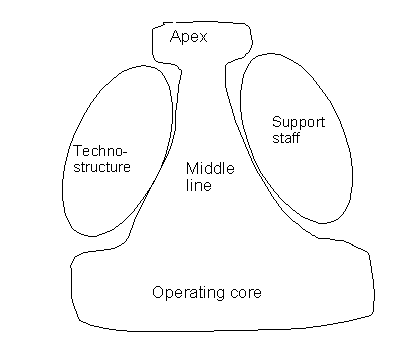
According to Henry Mintzberg, most organizations can be divided into 5 basic parts. Here is a diagram:

At the bottom of the organization is the operating core. These are the people that do the basic work of producing the products or delivering the services. In the simplest organizations, the operators are largely self-sufficient, coordinating through mutual adjustment. In those organizations, there is almost nothing but operating core.
As the organization grows, the need for direct supervision increases. This results in the development of a strategic apex, which in the simplest case is just a single manager. The apex is charged with ensuring that the organization executes its mission. They are responsible to the owners, government agencies, unions, communities, etc.
As the organization grows even larger, one manager can't handle all the workers, and so there are multiple managers of workers, plus a manager to manage the managers. This creates a middle line which transmits authority from the top to the bottom.
In Frederick Taylor's view, it was a primary responsibility of the managers to figure out how work should be done by the workers. However, as organizations become larger, they typically develop a separate group of people -- analysts -- who take on the job of figuring out what the company's technology should be and what the company's procedures should be. These analysts form the technostructure of the organization. The technostructure's mission is to effect coordination through standardization. For example, the industrial engineers standardize work processes; the strategic planners standardize outputs; and the personnel trainers and recruiters standardize skills.
Finally, the organization adds other administrative units that provide services to itself, such as a cafeteria, mailroom, legal counsel, public relations, etc. These are called the support staff.
The apex, middle line, and operating core are known collectively as line positions. In contrast, the technostructure and support staff are known collectively as staff positions. Originally, the meaning of these terms was that line positions had formal authority to make decisions, while staff positions did not: they advised those who did. Today, that meaning has shifted. Line refers to people that work directly on the main products of the company or manage the people who do. Staff refers to people who construct and maintain the company's infrastructure. In a way, staff positions are like roads while line positions are like the cars that run on top of the roads.
| Copyright ©1996 Stephen P. Borgatti | Revised: October 08, 1997 | Go to Home page |